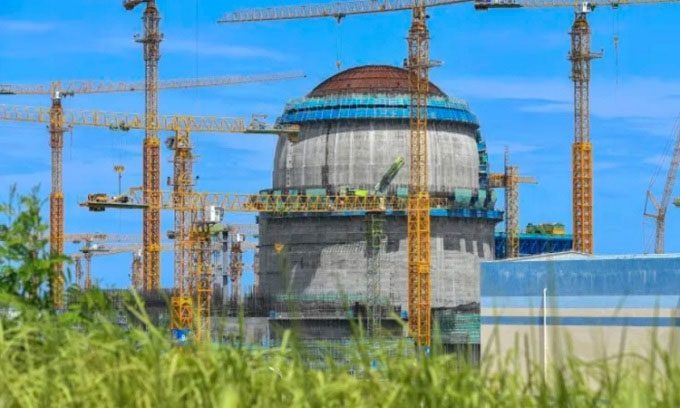China is leading the world in building nuclear reactors for electricity production, which helps to boost economic development and achieve zero-emission goals.
China has 21 nuclear reactors under construction, with a total capacity of over 21 gigawatts, according to the International Atomic Energy Agency (IAEA). This number is 2.5 times higher than the number of nuclear reactors under construction in any other country. India has the second-largest number of reactors under construction with 8 reactors, which can produce over 6 gigawatts. Turkey holds the third position with 4 reactors and an expected total capacity of 4.5 gigawatts, according to CNBC. (One gigawatt of electricity is enough to power a medium-sized city).

Construction site of the Xiangjiang nuclear power plant in Hainan, China. (Photo: China News).
“In fact, China is at the forefront of current nuclear technology“, said Jacopo Buongiorno, a professor of nuclear science and engineering at the Massachusetts Institute of Technology. Kenneth Luongo, president and founder of the Partnership for Global Security, a nonprofit organization focused on energy policy, nuclear issues, and transnational security, shares Buongiorno’s view. In terms of operational nuclear reactors, China ranks third in the world with 55 reactors and a capacity of over 53 gigawatts.
The demand for electricity arises from needs, so new nuclear reactors are often built in rapidly developing economies that require electricity to sustain growth. While over 70% of current nuclear capacity is located in OECD member countries, nearly 75% of reactors under construction are in non-OECD countries, with half of those in China, according to the World Nuclear Association.
China’s economic growth has also led to increased electricity production. The total electricity output in China reached 7,600 terawatt-hours in 2020, a significant rise from 1,280 terawatt-hours in 2000, according to the U.S. Energy Information Administration. Currently, nuclear energy accounts for only 5% of the total electricity produced in the country, while coal still makes up about two-thirds, according to the International Energy Agency. However, the reliance on coal to meet the surging electricity demand in China has come with air pollution issues. Nuclear power generation does not release greenhouse gases that contribute to air pollution and global warming, prompting China to turn to nuclear energy as a rapid way to produce clean energy.
China initiated its nuclear program by purchasing reactors from France, the United States, and Russia, then developed its own Hualong reactors (in collaboration with France). One reason for China’s rise to the forefront of nuclear energy is government support that enables the construction of multiple reactors at lower costs.
China continuously improves key nuclear power equipment developed domestically, enhancing its capacity to produce nuclear power equipment and ensuring related industrial supply chains. They have also developed the ability to supply complete sets of nuclear power equipment for Pressurized Water Reactors (PWRs) with a capacity of one million kW. In 2022, China produced 54 sets of nuclear power equipment, achieving a new high in the past five years.
“More than 90% of China’s large nuclear power reactors are now produced domestically. The technological level of China’s nuclear power engineering construction maintains a good international ranking, with the capability to build more than 40 nuclear power units simultaneously,” said Zhang Tingke, secretary-general of the China Nuclear Energy Association (CNEA).
By 2030, China is expected to lead the world in installed nuclear power capacity. According to CNEA, nuclear electricity production in the country is projected to account for 10% of total electricity output by 2035, enhancing the importance of nuclear power in China’s energy mix and thus promoting the transition to a low-carbon energy structure.


















































